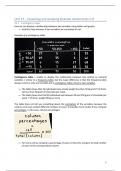Samenvatting
Summary of unit 13, 24, 12 and 15 from RMDS, all you need to know!
Comprehensive summary for research methodology descriptive statistics of unit 13, 24, 12 and 15. The most important keywords have been added with explanations.
[Meer zien]




